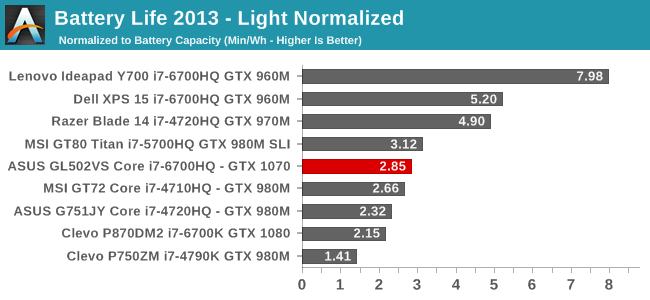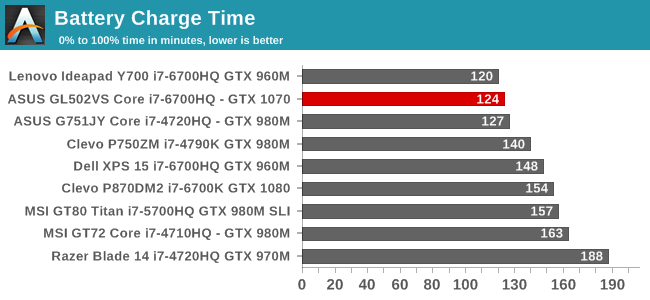The ASUS ROG Strix GL502VS Review: Mainstream GTX 1070 with G-SYNC
by Brett Howse on December 9, 2016 8:00 AM ESTBattery Life
On an Ultrabook, this section is one of the most important, but for a large gaming laptop like the ASUS GL502VS, it is very clear that this is not one of the primary focuses by the engineers. The reason for this is that the laptop has just a 62 Wh battery inside, which is about what you would get in a Dell XPS 13, and less than the Microsoft Surface Book. Some gaming laptops go for the full 99 Wh battery size. For those that are unaware, airline regulations only allow batteries in individual items of less than 100 Wh capacity, so that is the upper limit for now. ASUS has chosen to save a few dollars here and go with a much smaller battery though.
Helping matters is the lower resolution display. 1920x1080 on a 15.6-inch notebook is not high DPI at all, which will help battery life, and Intel’s Skylake lineup of CPUs has gains here too. With NVIDIA now on FinFET as well, there is a chance that the battery life can be decent.
All of our battery testing is done with the device set to 200 nits, and on wireless with the device set the default power setting.
2013 Light Battery Test

The light test involves just the browser, and opening four web pages per minute. It has become fairly simple for any of the race to sleep processors, and as such it is being phased out, but in order to give a better sample against older machines, the data is still useful.
With just a 62 Wh battery, the ASUS GL502VS ends up very near the bottom, with only the desktop CPU based Clevos below it. It falls just short of three hours on this test.
2016 Battery Life

The 2016 test is a more complex web browsing test, with more realistic page viewing. It in theory should be more taxing on the CPU than the 2013 version.
Interestingly the 2016 test follows the same result as the Clevo, with a score that is slightly higher than the older version of this test. At the end of the day, without having Optimus, the GPU still continues to be a big part of the power draw, masking the results of a bit more CPU work.
Normalized Battery Life


By removing the battery capacity from the equation, you can take a look at the overall platform efficiency. As a true gaming notebook, the ASUS GL502VS lacks NVIDIA’s Optimus technology, meaning the GPU is always running. This impacts battery life quite a bit despite the move to FinFET for Pascal.
You can see that the ASUS would have much better battery life if it just had a bigger battery. Overall efficiency is not too bad, although interestingly it is not quite as good as the SLI GTX 980M GT80 Titan. The laptops that offer Optimus, which are the Lenovo Y700, Dell XPS 15, and Razer Blade, all show a big step up in efficiency with the graphics turned off, and the Lenovo especially but it has a poor display which helps a lot. The 2016 results are a bit sparse at the moment, but will fill in over time with more devices to be tested.
Tesseract Score
Since one of the most obvious ways someone would use a laptop, even one like this, away from the wall socket is to play a movie, it makes sense to test this as well. For this we use the Tesseract score, which is simply how many times could you watch The Avengers, which is 143 minutes long.


The ASUS will get through one running of The Avengers, but if you decide to watch it another time, or just another movie, you are going to need somewhere to plug in.
Charge Time
Although the ASUS is generally going to be sitting on a desk plugged into power, there will be times where the laptop needs to be used away from the desk for a bit. Charge time can be important, especially when the overall battery life is not great.

The charge time for the ASUS is right near the top, which makes a lot of sense considering it has a much smaller than average battery to refill, but still has a hefty 180-Watt AC Adapter powering it.










54 Comments
View All Comments
milkod2001 - Friday, December 9, 2016 - link
$1600 is not mainstream by all means but it has very decent specs that that price. It should last at least 3 years no probs. The only thing i would want to change is screen size, should have been 17''.Brett Howse - Sunday, December 11, 2016 - link
They do sell the GL702VM as a 17.3-inch model, but only with GTX 1060. ASUS has the GTX 1070 and up in the G752 which is a nice machine.BrokenCrayons - Friday, December 9, 2016 - link
Mainstream is different for everyone, but I agree that even on the low-end of its price spectrum that this laptop is absolutely not mainstream. However, I understand when you're a writer you're compelled to throw something out there that ultimately can end up the subject of unforseen debate. Let's try not to get overly hung up on it since, really, its as unimportant as calling a penguin a fish. The only thing that's changed is the label. Nothing fundamental about the squishy inside bits of the penguin are made different in doing so.SharpHawk - Friday, December 9, 2016 - link
No thermal data on the CPU?shelbystripes - Friday, December 9, 2016 - link
I got the GL502VM on sale from Amazon for a ridiculous $899 on Black Friday. At that price it's an utterly amazing system, and even at regular price is one of the cheapest Nvidia 10-series systems around, though I have some comments about its performance that this article fails to mention. The article makes it seem like it's just a GL502VS with a 1060 instead of a 1070, and that's not the case:1) The GL502VM doesn't come with G-Sync. At least, the lower end models don't.
2) The base model uses a quad-core i5, which is slightly slower, but more importantly lacks hyperthreading. I've found HT to historically not make a huge difference, but it's worth noting.
2) The GL502VM comes with 8GB RAM soldered on. It has one SODIMM slot, so if you buy a 16GB model it includes one 8GB DIMM plus the soldered-on RAM. Max memory capacity is limited to 24GB, since you can't swap out one channel of 8GB for 16GB later.
3) The GTX 1060 inside is the 3GB model, which actually has not just less RAM but fewer cores than the 6GB model. Still sufficient for 1080p gaming in a lot of games, especially for a budget gaming laptop, but worth noting it's about more than just the RAM. (I'm not sure if there's a similar discrepancy between the 4GB and 8GB GTX 1070 models available in the GL502VS, but at least you can get the higher end model there.)
4) This is really a comment on both machines, but the base models come with a mechanical HDD only. There's still an M.2 slot in the base models, it's just unpopulated. Still, I snagged a cheap 2.5" SATA SSD on Black Friday, and just a little simple surgery (not difficult, but 10 screws just to open it up, plus 8 screws for the HDD mount!) later, I had a MUCH faster system than I would have otherwise.
And lastly, a general tip when self-upgrading to save money: Windows 10 doesn't come with activation keys, it syncs your system unique ID to your Microsoft account. Microsoft made clean-installing Windows 10 much easier, you can download a tool from Microsoft's website to make a Windows 10 USB installer, but you'll need to boot the system at least once on the mechanical HDD to activate the copy of Windows 10 it comes with and link it to your Microsoft account. Then you can yank the HDD, swap in an SSD, and do a clean install (even if you're adding an M.2 SSD and keeping the HDD, you may want to do a clean install onto the SSD to get rid of the crapware anyway) without any problem. Just log into your Microsoft account during the reinstall and it'll recognize you have a Windows 10 license for that device. If (like me) you were clinging to Windows 7 on your last machine, I figure this knowledge might be new and useful to you.
sundragon - Friday, December 23, 2016 - link
Thank you! I may do this on my 502VS.label47 - Friday, December 9, 2016 - link
If you play heavy games the Battery will drain while plugged in...https://rog.asus.com/forum/showthread.php?88742-GL...
jsntech - Friday, December 9, 2016 - link
Yikes. Wonder what happens when it gets down to 0%? The ASUS rep responding to one of the bunches of people with the same complaint is unfortunate: " I've PM you a message, please check your inbox, thank you". Like they're trying to run interference instead of just openly acknowledging and working with customers. "Support" like that is one of the reasons I am hesitant to go with ASUS and others like them (though the bigger players are no better...sigh).kvnobrien - Friday, December 9, 2016 - link
"ASUS would have much better battery life if it just had a bigger battery" - quote of the year. Thank you this made me chuckle. I get the point you were trying to make it's just funny though.marco89nish - Friday, December 9, 2016 - link
I fail to see usefulness of G-Sync on 60Hz 1080p display with GTX 1070. It should be very challenging to drop 1070 to under 60 fps in next few years. Adding 75/90/120Hz display instead of G-Sync would yield much better value in my opinion.